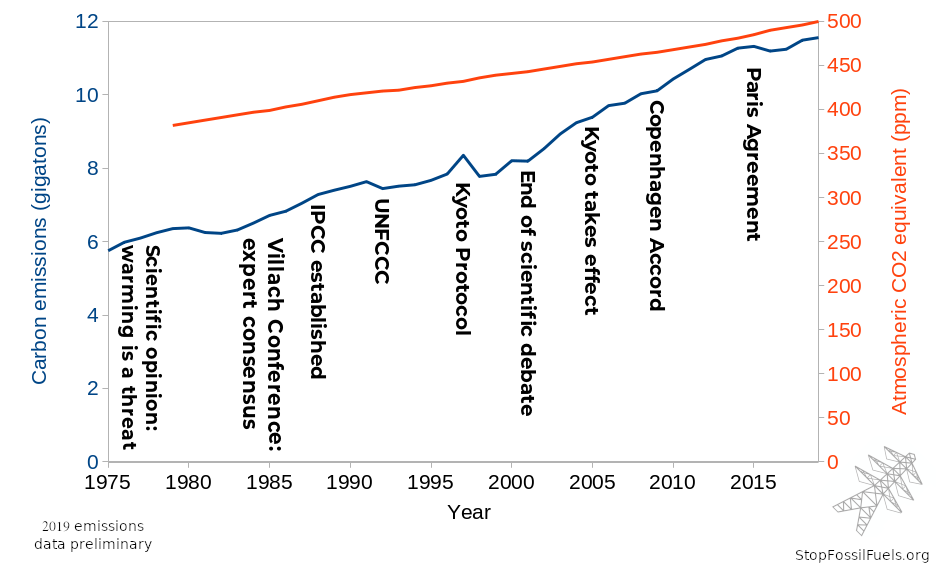Carbon Emissions & Atmospheric Concentration

Climate Disruption Timeline
Excerpted from American Institute of Physics’ The Discovery of Global Warming
See also a fascinating in-depth story of 1980s climate history: Losing Earth: The Decade We Almost Stopped Climate Change
1977: Scientific opinion tends to converge on global warming, not cooling, as the chief climate risk in next century.
1984: Villach Conference declares consensus among experts that some global warming seems inevitable, calls on governments to consider international agreements to restrict emissions.
1988: Intergovernmental Panel on Climate Change (IPCC) is established.
1992: Conference in Rio de Janeiro produces UN Framework Convention on Climate Change, but US blocks calls for serious action.
1997: International conference produces Kyoto Protocol, setting targets for industrialized nations to reduce greenhouse gas emissions if enough nations sign onto a treaty (rejected by US Senate in advance).
2001: Third IPCC report states baldly that global warming, unprecedented since the end of the last ice age, is “very likely,” with highly damaging future impacts and possible severe surprises. Effective end of debate among all but a few scientists.
2005: Kyoto treaty goes into effect, signed by major industrial nations except US. Work to retard emissions accelerates in Japan, Western Europe, US regional governments and corporations.
2009: Copenhagen conference fails to negotiate binding agreements: end of hopes of avoiding dangerous future climate change.
2015: Paris Agreement: nearly all nations pledge to set targets for their own greenhouse gas cuts and to report their progress.
Data sources
CO2 equivalent atmospheric concentration
The National Oceanic and Atmospheric Administration (NOAA) calculates the CO2 equivalent of all the greenhouse gases in the atmosphere, including methane, nitrous oxide, chlorofluorocarbon-12, and sixteen others. Figures are available from 1979 onward.
Carbon emissions
The Global Carbon Project maintains Global Carbon Budget data, tracking global emissions from fossil fuels & industry, and from land-use changes (that is, deforestation and destruction of grasslands primarily with the use of fossil fuels.)
Fossil fuel and industrial processes: Gilfillan, D., Marland, G., Boden, T. and Andres, R.: Global, Regional, and National Fossil-Fuel CO2 Emissions, available at: https://energy.appstate.edu/CDIAC, last access: 27 September 2019.
Land-use change: average of two bookkeeping models: Houghton, R. A. and Nassikas, A. A.: Global and regional fluxes of carbon from land use and land cover change 1850-2015, Global Biogeochemical Cycles, 31, 456-472, 2017; Hansis, E., Davis, S. J., and Pongratz, J.: Relevance of methodological choices for accounting of land use change carbon fluxes, Global Biogeochemical Cycles, 29, 1230-1246, 2015.
Consider supporting our work by joining our mailing list below, sharing & "liking" this page, and following us on social media. You may freely republish this Creative Commons licensed article with attribution and a link to the original.